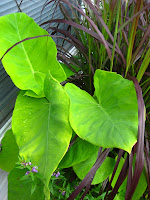 It's a long story but we had to have our deck powerwashed and restained. It was a job that needed to be done...badly, but it was incredibly ill-timed. However, circumstances were such that we decided to have it done last week which necessitated moving all 27 of my pots into the house, down our fifteen front steps and into the garage. It also meant that when the deck was finished, they would all have to be brought out from the garage, up the aforementioned fifteen steps, into the house and back out onto the deck. I was crossing my fingers that the contractors doing the job were of the punctual sort.
It's a long story but we had to have our deck powerwashed and restained. It was a job that needed to be done...badly, but it was incredibly ill-timed. However, circumstances were such that we decided to have it done last week which necessitated moving all 27 of my pots into the house, down our fifteen front steps and into the garage. It also meant that when the deck was finished, they would all have to be brought out from the garage, up the aforementioned fifteen steps, into the house and back out onto the deck. I was crossing my fingers that the contractors doing the job were of the punctual sort.Shown here is my wonderful hulk of a husband (face obscured by foliage) wrestling with just one of my plants. This is Lespedeza, a shrub that is perennial to zone 4. I've had it in the same pot for 4 years which I'm thinking now is a mistake because it is huge. I didn't realize it was such a behemoth until it was brought out of the open air and into the house. But I love this plant although it has been said that it is horribly aggressive and invasive. I can certainly see why it would be a challenge to contain it if it was part of a landscape. But that's the beauty of gardening in pots because plants are, by definition, contained. This one will have to be divided prior to next year's growing season. That's going to be a job.
It's not in bloom now, but will be later in August so stay tuned for those pictures. That's another reason I like it so much. It starts showing off right about the time that many of my other plants have nearly called it quits.
Bookshelf: Container Gardening Books



















